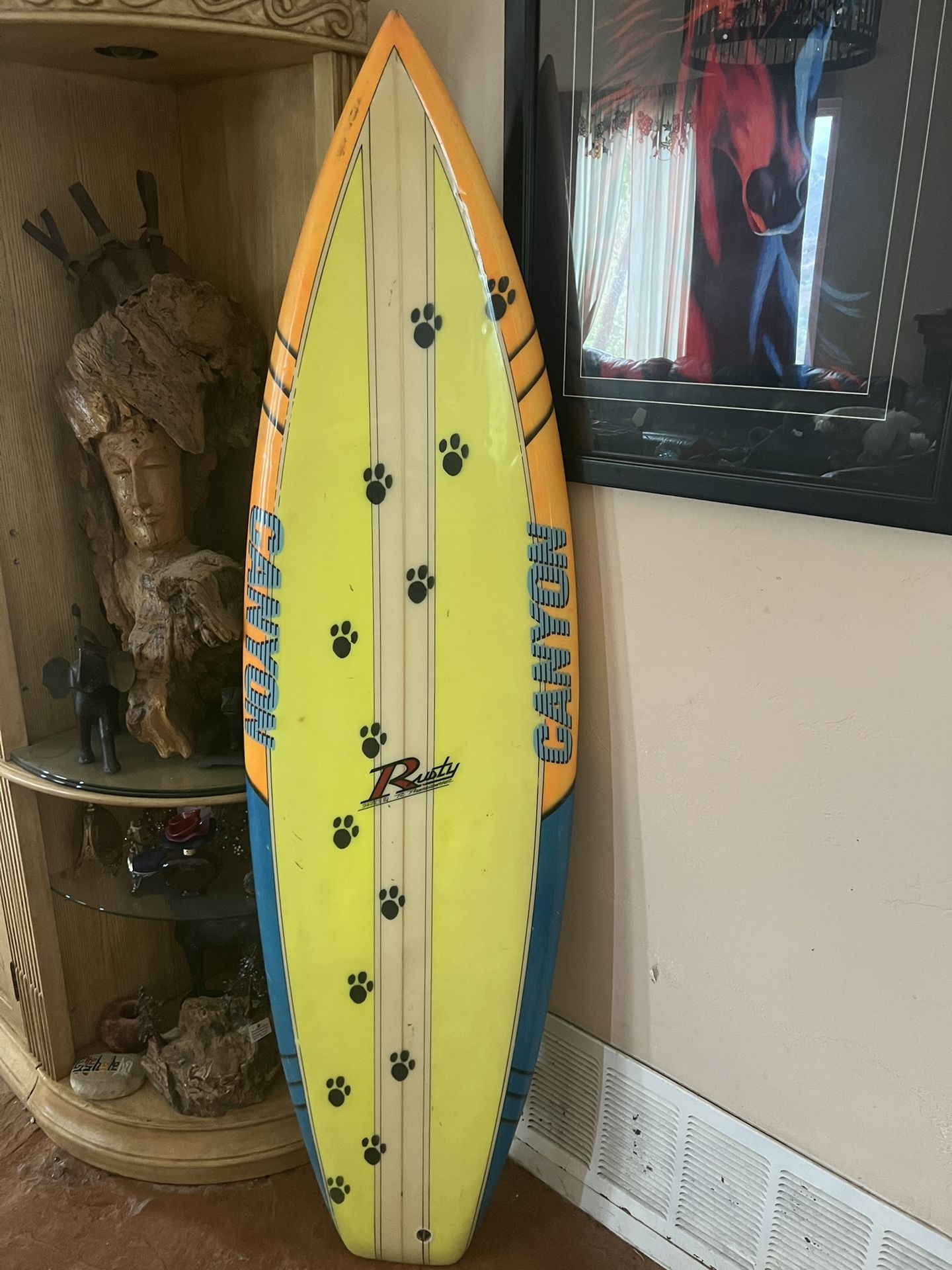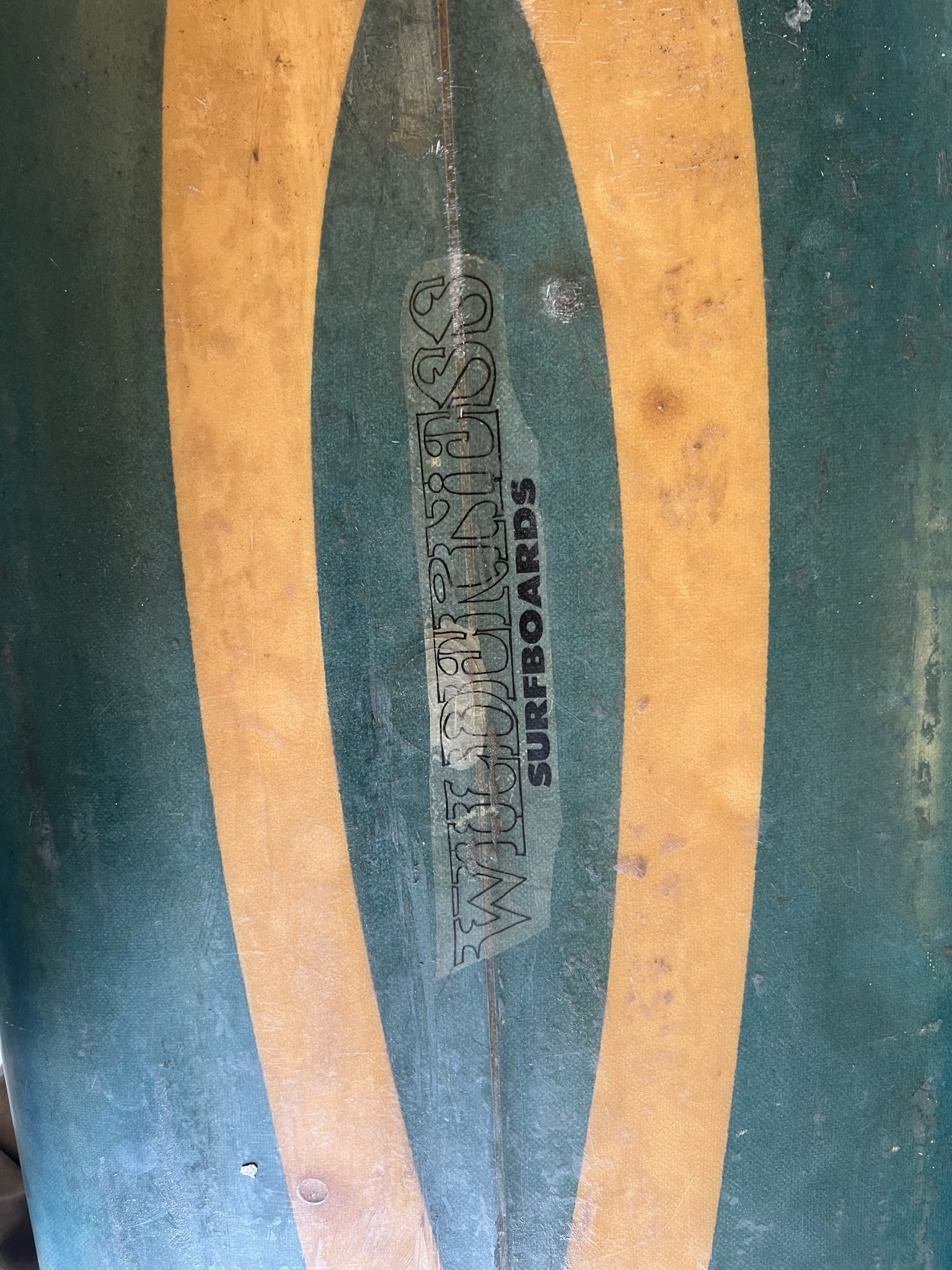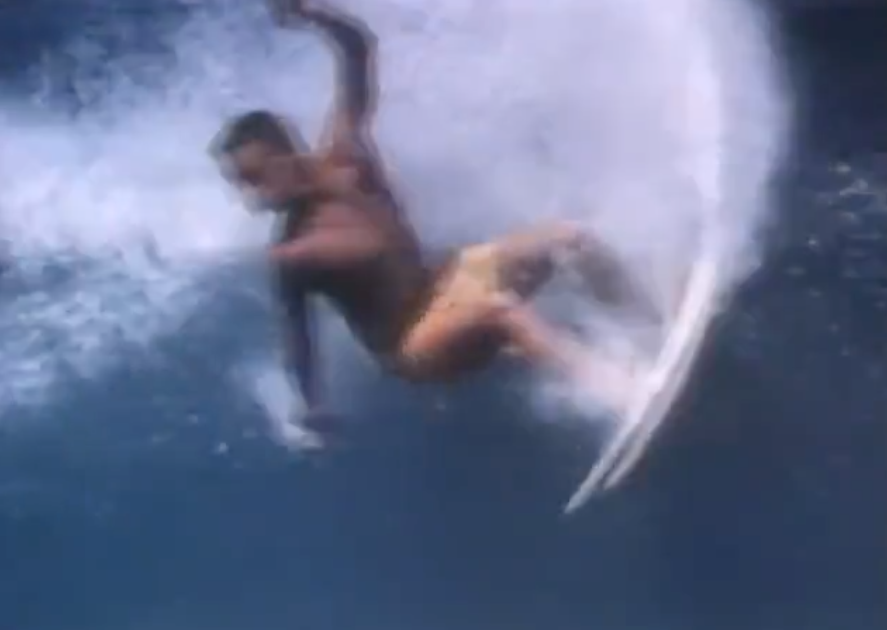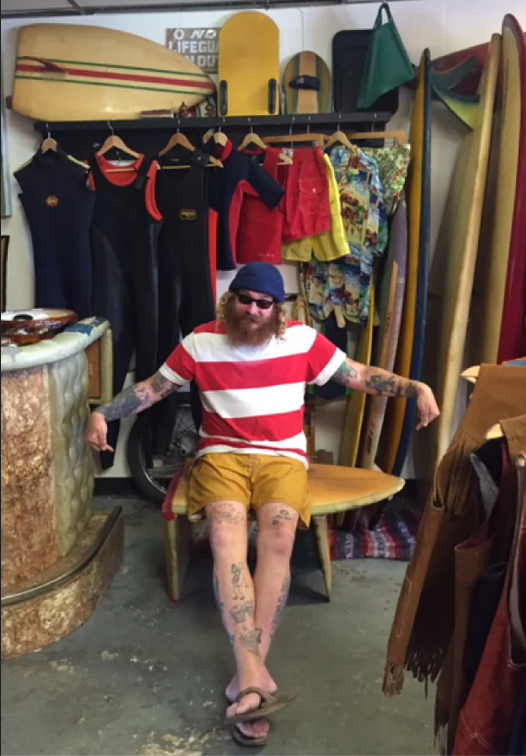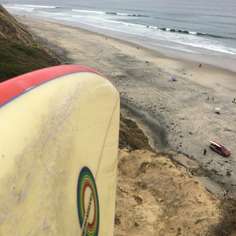
Prelude: Writer, photographer and copyright holder John Durant forwarded me this historical recollection with Rusty Preisendorfer describing perils and partners from his rise to worldwide surfing significance. Meet the founders, icons, and the real life surfing underground. Take a step back into the dense underground surf culture of San Diego (particularly La Jolla and Sunset Cliffs) from the worldwide hotbed of surfing innovation in the canyons of La Jolla, CA during the 1970’s. Take a journey back to discover the hotbed of surfing innovation going down at the Bridgeman house on Starlight Drive and the founding of brands that would be iconic across the world for surfing. Dustin
Rusty returned to California from Australia in spring of 1974. A few weeks later on a small early-summer go-out at La Jolla Shores, Rusty’s steady progression as a shaper was interrupted by an unpredictable twist. What should have been a laughably small encounter turned into a genuine catastrophe.
June, La Jolla Shores:
Mid-morning paddle out into gin-clear water. Small west swell, waves breaking in shallow water. Rusty – about to paddle out, hair still dry – when an older guy came trimming by – trying for a cheater five on the inside. Rusty had to back up a little bit and the surfer on the wave squeaked by him, but he buried the nose and let his board shoot back, hitting Rusty in the thigh.
The fin struck Rusty on the outside of his right thigh about halfway between the knee and his hip, ripping a four-inch gash right down to the bone. Profuse bleeding. Steve McCollum was there that morning and he ran Rusty up to Scripps Hospital at the top of the hill near the university using beach towels to staunch the bleeding. The wound required 30 or 40 internal stitches, and an additional 40 external stitches the length of the cut. Rusty had left his car in the lot at the shores and, after being stitched up, he went back, picked up his Rambler and went home to recover.
Rusty: I had this little Rambler – like a sedan, a little four-seater. I’d taken out the back seat so I could shove my boards through the trunk. I had that for about six months. I left the car in the lot and picked it up after they stitched me up. Back in those days it was pretty hard to keep me down, so I ran down and grabbed my car and went home.
A few days after Rusty went home to recover, the wound began to pulse with infection. He was living above The Shores at the Bridgeman house on Starlight Drive – at the time a hot-bed of surf experimentation. A next door neighbor to the north was a doctor. After four or five days Rusty started to develop a high fever and when the doctor came over to take his temperature he said, “You’re going to the hospital.” Rusty was running a temperature of 105 and was exhausted and delirious. They checked him into a hospital room for observation and after managing to lower his temperature, an orderly came in and said, “This looks like a pretty bad… ” a terse comment about the hole in his thigh. As the orderly was checking out the damaged tissue, he said, “You need to have this opened up.” A surgeon was called in and after cutting the stitches, the swollen wound just opened up like a filet. The gash had to heal from the inside out which took six weeks. Once home, Rusty had to bathe the infection site several times a day and soak the wound area – that’s one of the issues with a really deep infection. Eventually he got stitched back up but before they sent him home from the hospital, the medical staff gave him a spinal tap [for this procedure, the doctor or nurse inserts a hollow needle into the space surrounding the spinal column (subarachnoid space) in the lower back to withdraw cerebrospinal fluid for analysis].
The board that hit Rusty belonged to San Diego restaurateur Peter Pitts. At the time he owned a popular spot in Mission Beach called Krishna Mulvaney’s. A couple of weeks after being discharged from the hospital Rusty approached him to see if he’d care to help with the medical bills.
Rusty: This was way before I had any medical insurance or even any money at all – and this was when two or three thousand dollars really meant something [three thousand 1974 dollars is worth $19,919.00 fifty years later in 2024]. I was super-glad to have recovered but… the hospital bill was beyond expensive. But when I asked Pitts to chip in he just told me to (explicit) off.
Rusty: The accident and hospitalization happened in summer of 1974. After I healed up, I continued shaping at G&S. In the meantime I still had this horrendous hospital bill to settle. I had appealed to Peter Pitts – the guy who hit me – to help me with my medical bills. Back then, it was only maybe two or three grand for the four days in the hospital and all the procedures. And he said, “(explicit) you.” He was really obnoxious. I knew an attorney in La Jolla – Jim Weaver – who was a couple years older than me, so I had him try to handle it. He was a La Jolla guy, and I had him write Peter Pitts a letter, and true to form, Peter just said, “(explicit) you.”
Rusty: I’d only been having Bill Caster glass my boards for a few months and one day I came in to drop off some blanks and Bill sat me down and said, “You know, gosh, Rusty, I love doing work for you but we’re getting kind of busy and you’re going to have to find another glasser.” I think he’s the one that suggested John Durwood at Canyon. I could tell he was unhappy to deliver the news but what he didn’t tell me was the real reason – but he said he couldn’t glass my boards anymore and he suggested Canyon. It turned out the board that hit me that morning at La Jolla Shores belonged to Bill Caster’s silent partner Peter Pitts. Caster and Pitts co-owned Caster’s new factory off Miramar Road in San Diego. He was the primary investor in the factory and co-owner of the building. He surfed and he told Bill, “Get that mother(explicit) out of here,” because I’d approached Pitts to defray my medical bills. When I approached Pitts, I didn’t have any money and I’d just spent four days in the hospital. That was a lot of money back then. I said “If you could help me at all, I’d really appreciate it.” And he goes, “Ah, (explicit) you.” You know? Yeah. I mean, he was totally to blame. I tried to get out of his way and then he pearled and his board put (explicit) a giant hole in my thigh. I don’t even think he said he was sorry – but when I found out who he was and I asked him if he could help me out – I didn’t demand, I didn’t want 10,000 bucks – I just wanted a little bit of help with the medical bills. He said, “(explicit) off.” And the next thing I know Bill Caster’s telling me he can’t glass my boards anymore. I’m not sure if I put two and two together right then, but about a day or two later, somebody goes, “Oh yeah, the guy that hit you is Bill Caster’s investor.” [laughter] So that was the end of my deal with Caster. He was very sorry. So that’s when I approached Durward at Canyon.
Ernie Higgins (Caster Laminator): Peter Pitts was Bill Caster’s silent partner. Very silent in fact. Peter and Bill had just set up the new Caster factory in the Commerce Street building after moving up the hill from Sorrento Valley. Bill was never very open about the relationship. Bill and I would have breakfast every morning for – I don’t know, like five years – and he would never, or hardly ever mention Peter Pitts. He was truly a silent partner. The whole time I worked for Bill, I don’t think I saw Peter more than three times. Peter and Bill would talk on the phone – having to do with money because Peter owned half the building.
Rusty: I was healed up by the end of summer so I enrolled back at UC San Diego and really focussed on my education. I needed to make some kind of steady money, so I got a valet job parking cars at the La Valencia Hotel where I worked for a couple of years, eventually moving up to bellman. We wore these burgundy uniforms made of some kind of synthetic nylon or something. In the summer of 1975 I started reaching out, trying to find shaping work all over San Diego County – Sunset Surfboards for Ed Wright, Encinitas Surfboards for John Kies, Hank Byzak, anywhere I could get some shaping gigs. I’m pretty sure that’s the sequence of events. It is a shame, because later on, Bill Caster developed prostate cancer or something terrible. He was such a nice person. Why do all the nice people fucking get cancer? That’s how I ended up at Canyon. Durward had just started his production shop over on Santa Fe Street in PB and he was glassing boards for some of the G&S guys – Robin, Holly and Frye – so that’s how that started. And I had to pay all the medical bills out of my own pocket.
CANYON (John Durward)
Near the I-5 freeway in east Pacific Beach, nestled in a set of unremarkable concrete buildings somewhere between a British car garage and the old Consolidated Convair aircraft factory was Canyon Surfboards, John Durward’s glassing outfit.
Canyon Surfboards, named for Rose Canyon – the short north-south depression between the Mount Soledad and University City neighborhoods – was one of San Diego’s contract glassing outfits where independent surfboard makers and local garage shapers could have their shaped blanks finished. Sometime in 1973 Durward graduated from local Sunset Cliffs garage surfboard guy to full-time production outfit with a small facility occupying one bay in a row of six or seven identical single-story concrete tilt-ups in the perennial light-industry section of east PB. Over the years this commercial section of San Diego had seen everything from aircraft builders to sail lofts, bike shops to pet hotels. It’s remained almost unchanged for the last fifty years.
Connecticut native Durward arrived late in the California surfing boom, well after boards went short but early enough to find his footing as a shaper/glasser in his Ebers Street garage at a time of intense experimentation. Things were changing fast, boards were short and everyone from established surf companies like Gordon & Smith and Hobie to back-yard builders were trying on new ideas from twin fins to channel bottoms to downrail guns to eggs. It was during this let’s try anything period of experimentation that Durward opened Canyon and began glassing for fellow Point Loman John Holly, local standouts Skip Frye and Tony Staples, and anyone else that had $225 and needed a board glassed.
Durward was put together like a college linebacker with a quiet brooding disposition. HIs signature look was a skeptical scowl delivered from a chin-tucked defensive position. A shock of longish hair would often fall over his left eye causing John to lower his gaze from below. There were no deals at Canyon. Everybody paid the same price – pros, superstars, local heroes – they were all the same. No deals! was his tagline for anyone from shop rats to Hawaiians in town for the summer. Durward learned his chops glassing for Sunset Cliffs locals and polished his technique at Gordon & Smith where he picked up the myriad tips and tricks the pros all use but the garage soul guys didn’t have time to assimilate like – soaking your squeegee in acetone overnight or how to pin-line freehand like a hot-rod artist. By the time Durward opened Canyon he could do it all, from shaping to laminating – but he considered himself a virtuoso gloss and polish technician often reminding the shapers he came in contact with that it was the glass job that made the board – not the shape. In other words – he was hard-headed as hell.
Durward could shape… but when compared to the pool of talent in San Diego in the early 1970s – surfer/shapers like Skip Frye, Mike Diffenderfer, Donald Takayama or Billy Caster – John’s shaping was basic and unrefined, characterized by thick, squared off rails. Nobody came to Canyon for Durward’s shaping. They came because it was in town, closer to home than Caster’s factory off Miramar Road or Tony Channin’s set-up in Encinitas. They came because glassing in your garage could go wrong in so many ways. This was a basic supply and demand equation with Durward meeting the modest demands from La Jolla to Point Loma. Due to an extraordinary chain of events, this was all about to change in the summer of 1974.
Returning from an extended trip to Australia, Rusty had a set of sketches – rough drafts – for his next label, Music!
Rusty: While I was in Australia I started to dream about getting back into business for myself, making my own boards start to finish. I came up with a Music! With an added an exclamation mark just to jazz it up a little bit, maybe create some visual tension. After I got back, things had started to pick up at G&S. I started shaping there again but I’d asked Larry Gordon if he – well we had this conversation – I told him I had this idea for a label and I asked if he’d glass the first batch for me and he said – well, sure we’ll do some for you. But after about twenty boards Larry said, you know you’ve got to make up your mind whether you want to work for me or you want to work for yourself. So I thanked him for the three years of experience and said adios.
Rusty: At that time Bill Caster was becoming a kind of underground legend. He was a local San Diego shaper at a time when localism was particularly… potent. There was a quiet battle going on between the Skip Frye school of thought (You’ll fly an a Frye) and the Caster contingency (Caster goes faster). Not an all-out war but definitely defined territories. The Caster guys tended to stick to the La Jolla Reefs. You’d see the guys that rode Skip’s boards at La Jolla Shores or the beach breaks of PB with a little overlap at PB Point. I don’t think Caster had a global impact but in terms of San Diego shapers I thought his work was beautiful and I aspired to that level of quality – and his glass work was very clean. That was Ernie HIggins doing the laminating back then. So I approached Caster, because I heard he had just opened a new glass shop off Miramar Road in San Diego – that’s where Diamond Glassing ended up – I thought he might have room for a few more boards. Bill said, sure, I’ll glass them for you.
Rusty: Gordon & Smith production glasser Bob Boche ended up taking over the building after Caster passed away. Caster had suggested John Durward at Canyon Glass. Durward was finishing boards for about six different shapers when I came in – some of Mickey Freemont’s boards, Tony Staples, Seagull… Over time he said, “I’ll tell you what, I’ll give you all of my shaping if you give me all of your glassing.” And I’m like, “Okay, sounds good,” because he probably only shaped ten boards a year and they were pretty rough. That’s how I became involved with John. I graduated in the summer of ’78 from UC San Diego – I went back in the fall of ’74, put my head down and graduated in three years. Prior to ’78, I was picking up summertime jobs all over… Especially in North County, shaping for Sunset, John Kies, anywhere I could get some experience. I became more involved with John, exclusively involved with him, I think, by ’78. The first thing I wanted to change was the logo, because the logo was absolutely (explicitly) boring. We had an airbrusher, it was the ’78 or, ’79, when color was really starting to come on. Durward was old school. He liked to use, what was it? E-fiberglass cloth? He liked to use that cloth, an older cloth and an older type of resin that made the boards kind of yellow. So, they weren’t pure white. So I convinced him to get off that. If he had his way – if he was still alive, he’d probably still be doing gloss and polish resin tints. There was a time when, you know, like around 1980 or 1981, he did decent tints on boards, but airbrushing was important and people were asking for airbrush work. We got an airbrusher for a little while but he quit. John just said, ” (explicit} that.” I said, “John, we’ve got to have airbrusher.” So I learned how to airbrush. And so for about a year, no, a couple of years, I airbrushed. I’d shape all day in a rented storage garage down the street on West Mission Bay Drive behind Burger King – then I’d come in to Canyon after hours and airbrush. Pull all-nighters.
Epilogue: Before John Durward’s death from cancer, he passed on Canyon surfboard temples. Recently in Point Loma I got to spend time with these patterns for iconic surfboards. In their lot was the PP Special, another mid century modern masterpiece of a surfboard, that I hope rewarded Rusty for his tenacity to develop surfboards of worldwide significance. Dustin

